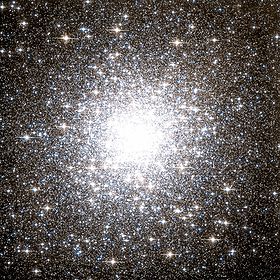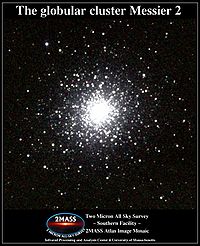- Messier 2
-
Messier 2 
Messier 2 by Hubble Space Telescope; 3.5′ view
Credit: NASA/STScI/WikiSkyObservation data (J2000 epoch) Class II Constellation Aquarius Right ascension 21h 33m 27s[1] Declination -00° 49′ 24″[1] Distance 37.5 kly (11.5 kpc) Apparent magnitude (V) +6.3[1] Apparent dimensions (V) 16′.0 Physical characteristics Radius 87.3 ly [2] Estimated age 13 Gyr Other designations NGC 7089[1] See also: Globular cluster, List of globular clusters Messier 2 or M2 (also designated NGC 7089) is a globular cluster in the constellation Aquarius, five degrees north of the star Beta Aquarii. It was discovered by Jean-Dominique Maraldi in 1746 and is one of the largest known globular clusters.
Contents
Discovery and visibility
M2 was discovered by the French astronomer Jean-Dominique Maraldi in 1746 while observing a comet with Jacques Cassini. Charles Messier rediscovered it in 1760 but thought it a nebula without any stars associated with it. William Herschel was the first to resolve individual stars in the cluster, in 1783.
M2 is, under extremely good conditions, just visible to the naked eye. Binoculars or small telescopes will identify this cluster as non-stellar while larger telescopes will resolve individual stars, of which the brightest are of apparent magnitude 13.1.
Characteristics
M2 is about 37,500 light-years away from Earth. At 175 light-years in diameter, it is one of the larger globular clusters known. The cluster is rich, compact, and significantly elliptical. It is 13 billion years old and one of the older globulars associated with the Milky Way Galaxy.
M2 contains about 150,000 stars, including 21 known variable stars. Its brightest stars are red and yellow giants. The overall spectral type is F4.[1]
 M2 from 2MASS sky survey
M2 from 2MASS sky survey
References
- ^ a b c d e "SIMBAD Astronomical Database". Results for NGC 7089. http://simbad.u-strasbg.fr/Simbad. Retrieved 2006-11-15.
- ^ distance × sin( diameter_angle / 2 ) = 87.3 ly. radius
External links
- M2,SEDS Messier pages
- M2, Galactic Globular Clusters Database page
- Historic observations of M2
- Messier 2 on WikiSky: DSS2, SDSS, GALEX, IRAS, Hydrogen α, X-Ray, Astrophoto, Sky Map, Articles and images
Messier objects List M1 · M2 · M3 · M4 · M5 · M6 · M7 · M8 · M9 · M10 · M11 · M12 · M13 · M14 · M15 · M16 · M17 · M18 · M19 · M20 · M21 · M22 · M23 · M24 · M25 · M26 · M27 · M28 · M29 · M30 · M31 · M32 · M33 · M34 · M35 · M36 · M37 · M38 · M39 · M40 · M41 · M42 · M43 · M44 · M45 · M46 · M47 · M48 · M49 · M50 · M51 · M52 · M53 · M54 · M55 · M56 · M57 · M58 · M59 · M60 · M61 · M62 · M63 · M64 · M65 · M66 · M67 · M68 · M69 · M70 · M71 · M72 · M73 · M74 · M75 · M76 · M77 · M78 · M79 · M80 · M81 · M82 · M83 · M84 · M85 · M86 · M87 · M88 · M89 · M90 · M91 · M92 · M93 · M94 · M95 · M96 · M97 · M98 · M99 · M100 · M101 · M102 · M103 · M104 · M105 · M106 · M107 · M108 · M109 · M110See also  Book:Messier objects ·
Book:Messier objects ·  Category:Messier objects
Category:Messier objects  Portal:AstronomyCategories:
Portal:AstronomyCategories:- Globular clusters
- NGC objects
- Messier objects
- Aquarius constellation
Wikimedia Foundation. 2010.
